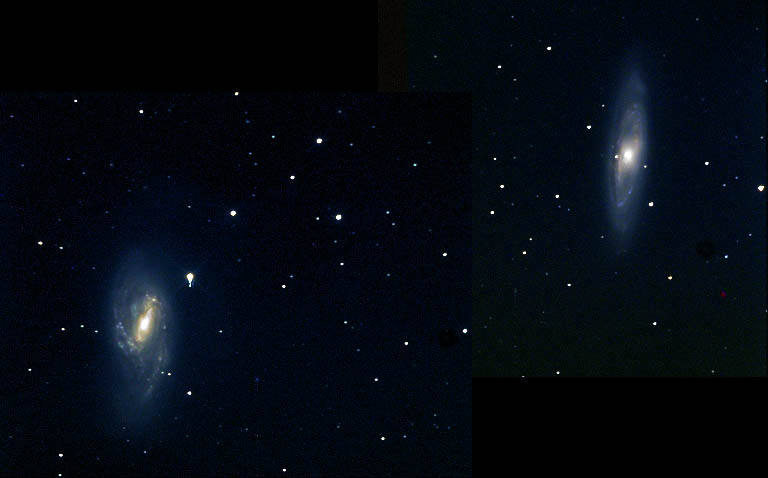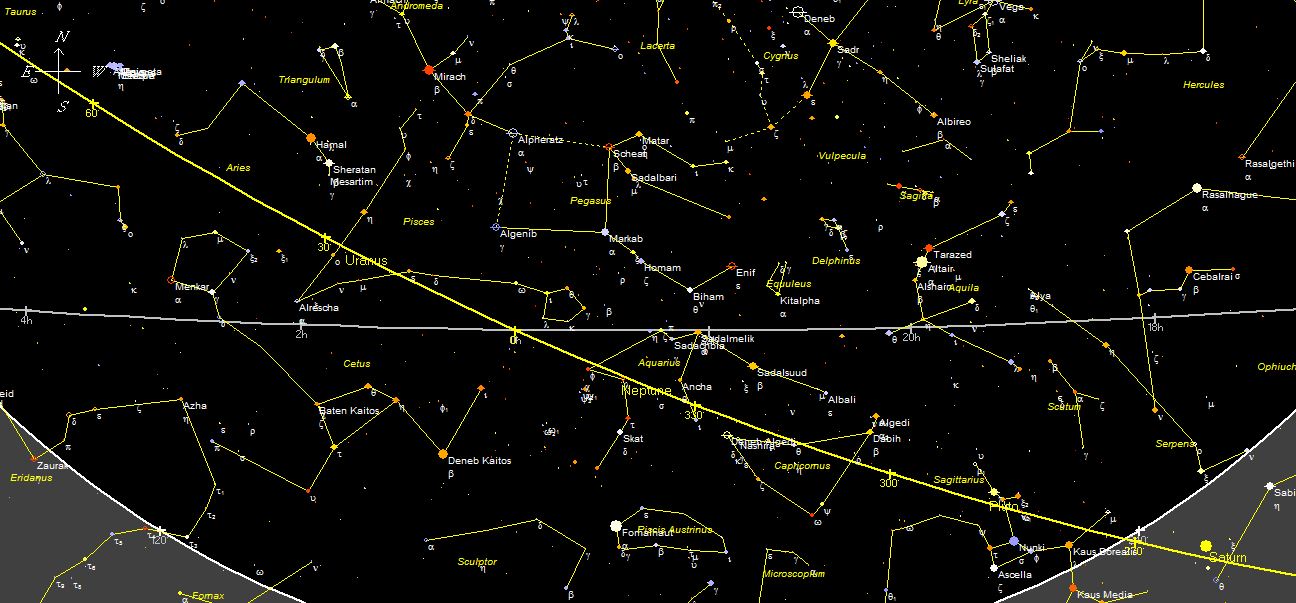The Sun from Aquarius passes, on March 12, in Pisces. Since the winter solstice in December, the Sun has been rising on the Ecliptic and it can be seen going through the daytime arches on the horizon higher and higher and wider, with the days getting longer. At the Spring Equinox, around March 20, the Sun reaches point γ, at the intersection of the Ecliptic and the celestial Equator; it rises precisely to the East and sets in the West. It runs through an arc that coincides with the celestial equator, a projection of the terrestrial equator into the sky.
Equinox comes from the Latin Aequinoctium = aequus (equal) nox (night): on this day the sun’s rays are perpendicular to the earth’s axis and the day is equal to night in every place on earth, except at the Poles where the Sun is on the horizon all day; at the Equator, the Sun at noon is at Zenith, at the highest point of the celestial vault.

In the evening sky we see summer constellations and in particular:
Lion
The constellation of the Lion is located south of the Great Bear, both of which are trapezius and are overturned with respect to each other. On the head of the Lion the mane is formed by a crescent of stars.
The Sun transits you from mid-August to mid-September. At the time of the Babylonians, however, the Sun was there at the ASolstizio in summer, hence the term “Solleone“.
Regolo, in α Leonis, is a binary system of stars, one of which is white-blue of mag.1.4 and the other is yellow of mag.7 at 77 light years. The name of Regolo “little king”, according to Pliny was assigned to him because the wandering stars occasionally pay him homage; the importance is due to the fact that Hipparchus, in 130 BC, studying its positions with respect to Spica della Vergine and comparing it with the respective positions found by the Babylonians around 2000 BC. discover the precession of the equinoxes.
Algieba (mane), γ Leonis, is a double composed of two orange giants of mag. 2 and 3.5 that rotate around each other with a period of about 620 years, to 126 a.l
The Lion has a large number of galaxies that belong to the same cluster, at 38 million a.l., not very far from the Local Group of which our galaxy is part, Milky Way, All, however, are difficult to observe with small instruments.
The brightest ones, under Chertan, are NGC 3628 at the top of E and below M65 at E with M66 at W, two spiral galaxies, all of which mag.9 distant 31 million a.l.


About halfway below θ and Leonis, there is M105, an elliptical galaxy that appears round with a brighter central part; it forms a triangle of galaxies with an East NGC 3384 above and NGC 3377 below;

NGC 3377, NGC 3384 and M105
Further down to W there are M96, (on the right) a spiral galaxy seen from the front and M95, a slightly inclined galaxy. They are also 31 million a.l.

Mythology
The constellation represents the lion who lived in a cave near the city of Nemea, near Corinth. He was fierce and invulnerable, in fact his skin could not be pierced by any weapon. In his first effort, Hercules confronted him and killed him by suffocating him with the strength of his arms: then he used the claws of the beast to detach his skin, which he then used to cover himself.

Minor Leo
It is a very weak constellation, introduced by Hevelius in 1690; it is included between the legs of the Ursa Major and the Lion head. It does not contain particular objects visible with small telescopes. Curiously, it does not have an Alpha star, although there is a star Beta Leonis Minoris: this seems to be due to an oversight by the English astronomer Francis Baily, who by mistake left the brightest star without a letter. All other stars are indicated only with Flamsted numbers. It seems that Hevelius, had given this star the name of Praecipua (“principal”, in Latin), but this denomination had no luck.

Today the brightest star of Leo Minor is identified with the Flamsteed number: 46 Leonis Minoris. Interesting is NGC 3344 a spiral galaxy seen in front of 27 million a.l.
Mythology
The constellation was identified and designed by Johannes Hevelius, so he does not have a history in classical mythology.

Berenice’s hair
The constellation Chioma of Berenice is located between Arturo and the Lion formed by weak stars of which the brightest is not α, Diadema, of mag. 5 to 47 a.l. but β, a double star of mag. 4.3 with a partner of May 10. Most of the stars are located below g and form an association of stars called Melotte 111, recognizable by binoculars. In it there is the cluster of about 1000 Cheomax galaxies distant 40 million a.l.
Mythology

In mythology, it is associated with the queen of Egypt, Berenice, who sacrifices her beautiful and flowing hair to the gods to obtain the salvation of her husband Ptolemy III at war with the king of Syria. The gods satisfy her and her crown in memory of her sacrifice was placed in the sky as a constellation.
__________________________________________
The maps of the sky are taken from Skymap, software downloadable in demo version from the site http://www.skymap.com
Credits
Author: Lucia Corbo. As a Natural Sciences teacher and expert in didactics of Astronomy, she has collaborated with various magazines curating articles, columns, and multimedia materials. For the Italian Ministry of Education, she edited the cd “Students show the stars” and with N. Scarpel the book “Astronomy on the net”; she promoted and coordinated the first editions of Astronomy Weeks for schools. She has held multiple refresher courses on the didactics of Science and Astronomy and Astronomy courses for students and adults, both in presence and online.
Translation by Maria Antonietta Sessa




